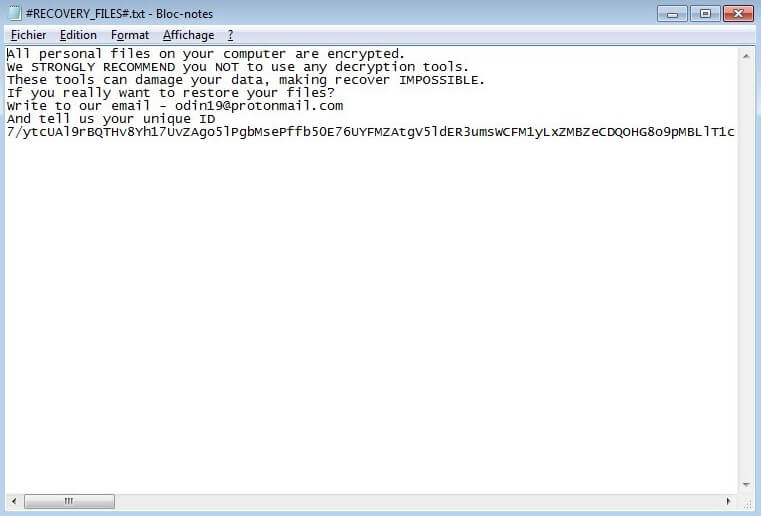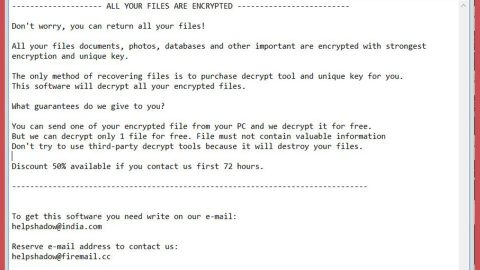What is XARCryptor ransomware? And how does it implement its attack?
XARCryptor ransomware is a cryptovirus discovered recently. It is reported to be the new variant of GarrantyDecrypt ransomware. Nothing much has changed in this new variant except for its ransom note and the extension it uses to mark its encrypted files which are “.odin”. Once XARCryptor ransomware infiltrates the system, it connects it to a remote server. After that, it creates and downloads more malicious files and places them on system folders.

It then proceeds to make modifications in the Windows Registry by modifying some existing registry keys like RunOnce as well as create new ones to allow it to run on every system boot automatically. It also employs two modules namely, data harvesting and stealth protection modules. The first module is used to gather information from the computer and use it for the second module which is the one that bypasses any security programs installed in the system that could interfere with the attack. It then scans the computer for files with specific formats such as:
.3dm, .3g2, .3gp, .7zip, .aaf, .accdb, .aep, .aepx, .aet, .ai, .aif, .as, .as.txt, .as3, .asf, .asp, .asx, .avi, .bmp, .c, .class, .cpp, .cs, .csv, .dat, .db, .dbf, .doc, .docb, .docm, .docx, .dot, .dotm, .dotx, .dwg, .dxf, .dxf.c, .efx, .eps, .fla, .flv, .gif, .h, .idml, .iff, .indb, .indd, .indl, .indt, .inx, .jar, .java, .jpeg, .jpg, .js, .m3u, .m3u8, .m4u, .max, .mdb, .mid, .mkv, .mov, .mp3, .mp4, .mpa, .mpeg, .mpg, .msg, .pdb, .pdf, .php, .plb, .pmd, .png, .pot, .potm, .potx, .ppam, .ppj, .pps, .ppsm, .ppsx, .ppt, .pptm, .pptx, .prel, .prproj, .ps, .psd, .py, .ra, .rar, .raw, .rb, .rtf, .sdf, .ses, .sldm, .sldx, .sql, .svg, .swf, .tif, .txt, .vcf, .vob, .wav, .wma, .wmv, .wpd, .wps, .xla, .xlam, .xll, .xlm, .xls, .xlsb, .xlsm, .xlsx, .xlt, .xltm, .xltx, .xlw, .xml, .xqx, .zip
After finding its targeted files, XARCryptor ransomware encrypts them AES cryptography. Following its encryption of the files, it appends .odin extension in every compromised file. You will then see a text file named “#RECOVERY_FILES#.txt” which contains the following content:
“All personal files on your computer are encrypted.
We STRONGLY RECOMMEND you NOT to use any decryption tools.
These tools can damage your data, making recovery IMPOSSIBLE.
If you really want to restore your files?
Write to our email [email protected]
And tell us your unique ID
7/ytcUAl9rBQTHv8Yh17UvZAgo5lPgbMsePffb50E76UYFMZAtgV5ldER3umsWCFM1yLxZMBZeCDQOHG8o9pMBLlT1c”
How does XARCryptor ransomware proliferate?
XARCryptor ransomware proliferates in various ways. It may spread via a payload dropper that initiates the malicious script used for the crypto-virus to run in the system. It might also spread by hacking into unprotected RDP configuration, exploit kits and fake software updates which is why you must always keep your computer protected by constantly updating the system and all the antivirus and security programs installed in it.
Wipeout XARCryptor ransomware from your computer using the given removal guide below.
Step_1: First, you have to stop the malicious process of XARCryptor ransomware by opening the Task Manager. To do that, simply tap Ctrl + Shift + Esc keys on your keyboard.
Step_2: Under the Task Manager, switch to the Processes tab and find a process named Wmiprvse.exe as well as any suspicious-looking process that takes up most of your CPU’s resources and is most likely related to XARCryptor ransomware.
Step_3: After that, close the Task Manager.
Step_4: Tap Win + R, type in appwiz.cpl and click OK or tap Enter to open Programs and Features under Control Panel.
Step_5: Under the list of installed programs, look for XARCryptor ransomware or anything similar, and then uninstall it.
Step_6: Next, close the Control Panel and tap Win + E keys to launch File Explorer.
Step_7: Navigate to the following locations below and look for XARCryptor ransomware’s malicious components such as “#RECOVERY_FILES#.txt”, Wmiprvse.exe, [random].exe, and other suspicious files, then delete all of them.
- %TEMP%
- %WINDIR%\System32\Tasks
- %APPDATA%\Microsoft\Windows\Templates\
- %USERPROFILE%\Downloads
- %USERPROFILE%\Desktop
Step_8: Close the File Explorer.
Before you proceed to the next steps below, make sure that you are tech-savvy enough to the point where you know exactly how to use and navigate your computer’s Registry. Keep in mind that any changes you make will highly impact your computer. To save you trouble and time, you can just use Restoro, this system tool is proven to be safe and excellent enough that hackers won’t be able to hack into it. But if you can manage Windows Registry well, then by all means go on to the next steps.
Step_9: Tap Win + R to open Run and then type in Regedit in the field and tap enter to pull up Windows Registry.
Step_10: Navigate to the following path:
- HKEY_CURRENT_USER\Control Panel\Desktop\
- HKEY_USERS\.DEFAULT\Control Panel\Desktop\
- HKEY_LOCAL_MACHINE\Software\Microsoft\Windows\CurrentVersion\Run
- HKEY_CURRENT_USER\Software\Microsoft\Windows\CurrentVersion\Run
- HKEY_LOCAL_MACHINE\Software\Microsoft\Windows\CurrentVersion\RunOnce
- HKEY_CURRENT_USER\Software\Microsoft\Windows\CurrentVersion\RunOnce
Step_11: Delete the registry keys and sub-keys created by XARCryptor ransomware.
Step_12: Close the Registry Editor and empty the Recycle Bin.
Try to recover your encrypted files using the Shadow Volume copies
Restoring your encrypted files using Windows Previous Versions feature will only be effective if XARCryptor ransomware hasn’t deleted the shadow copies of your files. But still, this is one of the best and free methods there is, so it’s definitely worth a shot.
To restore the encrypted file, right-click on it and select Properties, a new window will pop up, then proceed to Previous Versions. It will load the file’s previous version before it was modified. After it loads, select any of the previous versions displayed on the list like the one in the illustration below. And then click the Restore button.
Congratulations, you have just removed XARCryptor Ransomware in Windows 10 all by yourself. If you would like to read more helpful articles and tips about various software and hardware visit fixmypcfree.com daily.
Now that’s how you remove XARCryptor Ransomware in Windows 10 on a computer. On the other hand, if your computer is going through some system-related issues that have to get fixed, there is a one-click solution known as Restoro you could check out to resolve them.
This program is a useful tool that could repair corrupted registries and optimize your PC’s overall performance. Aside from that, it also cleans out your computer for any junk or corrupted files that help you eliminate any unwanted files from your system. This is basically a solution that’s within your grasp with just a click. It’s easy to use as it is user-friendly. For a complete set of instructions in downloading and using it, refer to the steps below
Perform a full system scan using Restoro. To do so, follow the instructions below.













